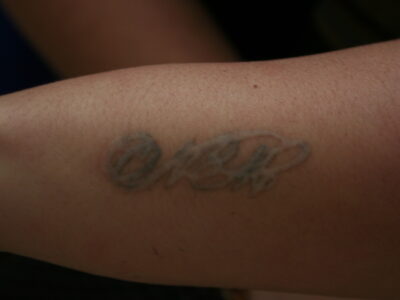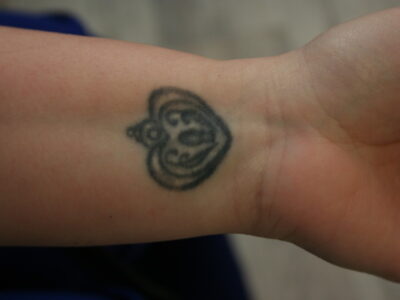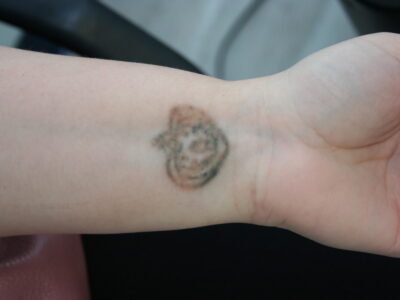What is tattoo removal?
As the number of tattoos increased in the world, the number of people who desire tattoo removal has also increased. We offer several lasers for tattoo removal including Nd: YAG and Alexandrite lasers. Laser energy targets the ink particles and breaks them into smaller fragments and it is believed that the immune system clears these ink particles. It takes multiple treatments to achieve the best possible results. Black and blue colors are relatively easy to remove whereas green is very difficult.
How does laser tattoo removal work?
Laser tattoo removal sends pulses of laser wavelengths into the skin. Wavelengths are adjusted to target different pigments in the tattoo. As light energy gets absorbed into the skin, it breaks apart the particles of pigment beneath the epidermis. Fragmented particles become easier for the body to remove through immune responses. Each laser session breaks pigment particles down further to make them easy for the immune system to flush.
Schedule a Consultation
If you are interested in tattoo removal and would like to see if you are a good candidate, please contact us today at (617) 381-1717 or send us a message below to schedule a consultation.
How many Laser Tattoo Removal treatments are needed?
This is a twofold question. One is how many treatments are needed and the other is how long it will take for the tattoo to fade. The answer varies from person to person because it depends on the body’s natural ability to eliminate the fragments of pigment from the skin.
Tattoo pigment may fade throughout 5 to 8 treatments. However, some people see results in fewer treatments and others need 10 or more sessions to fully dismantle tattoo ink. The number of treatments can be estimated during the initial consultation but patients should understand that this could change based on their immune response to the laser.
What Factors Influence How Many Laser Tattoo Removal Sessions are Needed?
Factors that influence the speed of laser tattoo removal include:
- Patient’s skin type
- Ink colors
- The location of the tattoo
- Whether or not the tattoo is a cover-up
- The amount of pigment in the tattoo
- The presence of tattoo scars
How far apart should tattoo removal sessions be?
Laser treatments are typically scheduled several weeks apart to give the immune system time to naturally flush ink particles. Scheduling is also carefully planned to ensure the skin is not bombarded with too much laser energy. With the timing of treatments and the body’s process of elimination, it is not uncommon to see results fade over the course of a year.
Does Laser Tattoo Removal Require Anesthesia?
Most small tattoos can be treated without anesthesia however larger and multi-color tattoos may need topical or local anesthesia.
Does laser tattoo removal hurt?
Patients should expect laser tattoo removal to be uncomfortable but tolerable. Most patients expect that laser treatment will be excruciating. It isn’t. Sensations of discomfort are typically less than or comparable to the feeling of getting a tattoo. Laser treatments may cause a snapping sensation or “zaps” of heat. A soothing cream or ointment may be applied before or after treatment to reduce these effects.
Is Laser Tattoo Removal Safe?
Laser tattoo removal is often considered the safest of all removal methods. Others, such as salabrasion, dermabrasion, and excision are more invasive and risky than a series of laser treatments. Risks associated with laser tattoo removal are generally minor and limited to:
- Infection at the tattoo site.
- Hypopigmentation, which can leave skin lighter in the treatment area than surrounding skin.
- Scarring is a minor risk that can be decreased by obtaining treatment from an experienced professional.
Will laser tattoo removal leave a scar?
Understandably, patients want naturally clear and healthy skin after their tattoo removal treatment is complete. Scarring from the laser removal process is very rare. However, what patients need to know is that tattooing itself can cause scars. If scarring had occurred from the initial tattoo, it will remain after the removal process is complete.
Are there any side effects of laser tattoo removal?
Some level of side effects should be expected. Usually, side effects are limited to:
- Redness
- Swelling
- Tenderness
- Scabs
- Blistering
- Bruising
- Hyperpigmentation
- Hypopigmentation
When proper protocols are used during and after treatment, all side effects from laser tattoo removal are expected to resolve quickly. Swelling, redness, and tenderness are typically gone within a day or two. Blistering may occur within 24 hours after laser treatment. These can sometimes be quite large and may appear alarming. Blistering is completely normal and can take up to a week to go away.
What is hyperpigmentation and hypopigmentation?
Hyperpigmentation and hypopigmentation relate to the body’s production of melanin, which can be altered by laser treatment. Hyperpigmentation occurs when melanin production increases. Hypopigmentation occurs when melanin is depleted. Each of these side effects is expected to resolve over time but may take several weeks. Patients should avoid sun exposure after laser tattoo removal to prevent unnecessary side effects.






